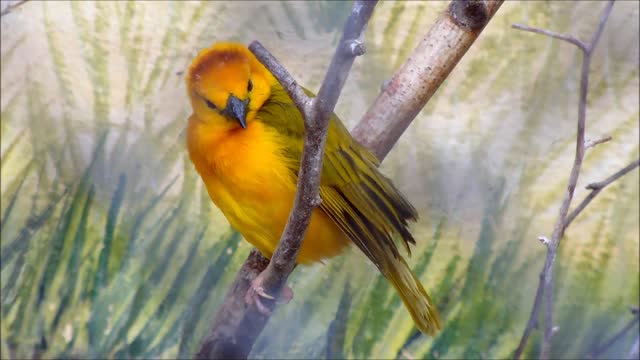Premium Only Content

Male Orange Weaver Bird Ran From Shooter on Branch
Male Orange Weaver Bird Ran From Shooter on Branch , Weaver birds build exquisite and elaborate nest structures that are a rival to any human feat of engineering. Some of these nests are the largest structures to be built by birds.
Weaver birds are a group of several families of small passerine birds that are related to the finches. Most weaver birds are yellow, but there are also red, brown or black varieties. They are commonly known for their construction of elaborate nests.
Their blunt, conical bills allow them to easily feast on seeds and grain, with some weaver birds, such as the red-billed quelea featured below, proving a massive problem for crop farmers.
The Ploceidae weaver finches are the most common, with 64 individual species. Most weaver finches can be found in Sub-Saharan Africa, with five Asian and two Madagascan species.
Weaver bird nests are extraordinary structures.
Most individual nests are cylindrical in shape, with downward-facing, narrow entrances that are usually situated over or next to water.
Ensuring that the entrance faces downwards and is as narrow as possible deters thieves and potential predators. Some nests even have a long tube, extending the entrance further beneath the nest body.
Having selected a good location for his nest, the weaver bird starts to loop and weave strands of grass or strips of leaves around the ends of one or two branches in a tree. Having created a looped basis for the nest body, the weaver bird then builds the hollow body before adding the tubular entrance last.
The males are the main weavers, leaving the females with the responsibility of selecting their breeding-partner. They do this based on the location, design and relative comfort of the nest which ensures the good genetic quality for the father of her offspring alongside a safe home for her eggs.
The sociable weaver of southern Africa builds large, permanent nests for a community of birds, usually found around areas where the stiff, dry grass they use as a building material can be found. Some of these nests are the largest structures built by birds.
Usually found spread throughout the branches of certain trees, sociable weavers have also been known to take advantage of telegraph poles and other tall, man-made structures. The nests resemble a a pile of hay in the tree with entrance holes placed underneath in order to deter nest invaders.
The nests provide a more consistent environment for sociable weavers who inhabit an area whose climate can see a fluctuation of extremes. Protected from the intense heat of the day and sometimes brisk night-time temperatures, sociable weavers can raise their young and ride out extreme weather in relative comfort, all the time safe in the knowledge that they are surrounded by members of their own species. However, despite this "safety in numbers" it has been found that nest raiding can be quite high with up to 80% of young not making it to adulthood.
The red-billed quelea is the world's most abundant wild bird, with some estimates numbering them in the billions. Perhaps even as high as 10 billion!
Found throughout sub-Saharan Africa, except the forests and the southern tip, they can congregate in vast swarms that can clear swathes of crops, proving to be a massively destructive pest. Some extreme methods of control include the burning of roosting colonies with napalm.
-
 2:31
2:31
Thailand Birds
3 years agoBaya Weaver bird video
31 -
 1:05:28
1:05:28
Flyover Conservatives
17 hours agoUkraine’s Dirty Secret: The Christian Persecution No One Wants to Talk About - Alex Newman | FOC Show
23.5K10 -
 2:00:20
2:00:20
Glenn Greenwald
10 hours agoThe View from Moscow: Key Russian Analyst Aleksandr Dugin on Trump, Ukraine, Russia, and Globalism | SYSTEM UPDATE #414
70K26 -
 1:10:55
1:10:55
Donald Trump Jr.
7 hours agoBREAKING NEWS: My Father Revokes Biden-Maduro Oil License, LIVE with Maria Corina Machado | Triggered Ep.220
162K180 -
 1:25:29
1:25:29
Sarah Westall
5 hours agoX-Files True History, Project Blue Beam, Cabal Faction War w/ Former FBI Agent John DeSouza
57.4K5 -
 7:03:49
7:03:49
Dr Disrespect
13 hours ago🔴LIVE - DR DISRESPECT - NEW PC VS. DELTA FORCE - MAX SETTINGS
146K26 -
 49:04
49:04
Lights, Camera, Barstool
1 day agoIs The Monkey The Worst Movie Of The Year?? + Amazon Gets Bond
57.4K4 -
 24:19
24:19
Adam Carolla
1 day agoDiddy’s Legal Drama Escalates, Smuggler Caught Hiding WHAT? + Philly Eagles & The White House #news
74.3K16 -
 10:12
10:12
Mike Rowe
2 days agoClint Hill: What A Man. What A Life. | The Way I Heard It with Mike Rowe
96.2K10 -
 1:31:52
1:31:52
Redacted News
8 hours agoBOMBSHELL! This is war! FBI whistleblowers reveal Epstein files being destroyed? | Redacted News
167K362